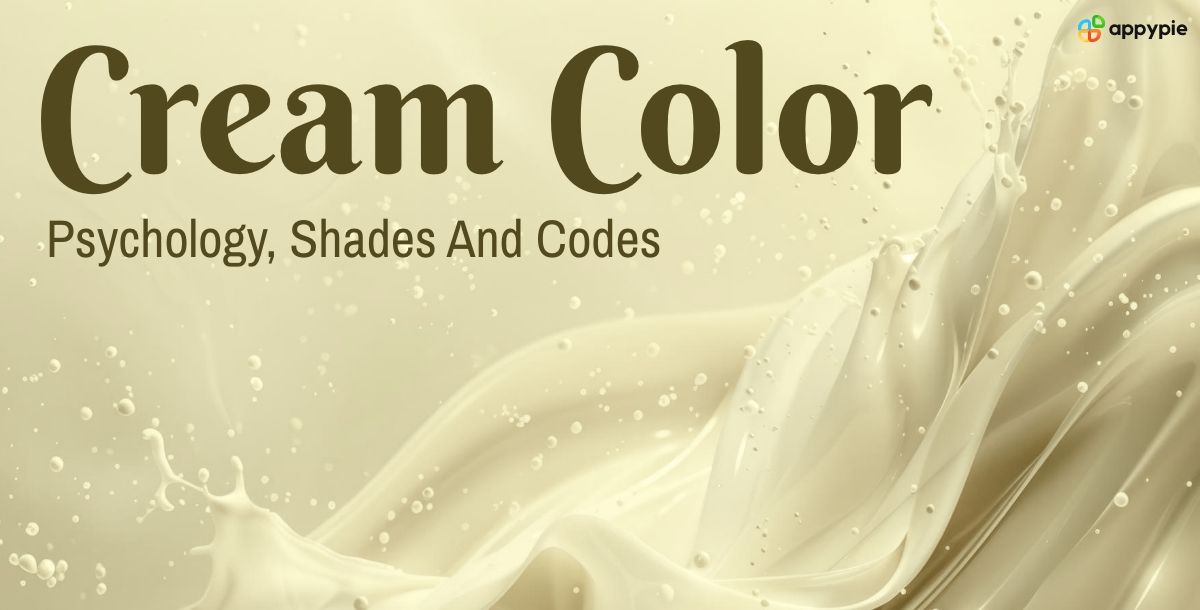Cream is a soft, warm color that sits between white and yellow color. It is often associated with calmness, elegance, and simplicity. Cream is a versatile color that can be found in nature, fashion, interior design, and art.
Understanding the cream color, its shades, and how it affects our psychology can help us make better choices in design and decoration. Whether you're painting a room, choosing an outfit, or creating a digital design, knowing about the cream color can enhance your work and make it more appealing.
In this blog, we will explore the meaning, psychology, significance, different shades, and color codes of cream color. We will also see, how Appy Pie’s AI Design Tools can come in handy for you in your work of designing.
Table of Content
Meaning of Cream Color
In this section, we will understand the significance of the cream color in the context of history as well as understand it's symbolism and cultural associations.
Historical Significance of the Cream Color
The color cream has been used for centuries in various cultures around the world. Historically, cream was often associated with luxury and wealth because it was a color found in fine materials like ivory, pearls, and certain types of silk.
In ancient times, the rich and powerful used cream-colored fabrics and decorations to show their status. For instance, in ancient Rome, cream-colored togas were worn by those of high rank. Similarly, during the Renaissance period, cream-colored clothing and tapestries were popular among the European elite.
Symbolism and Cultural Associations
The cream color symbolizes calmness, purity, and sophistication. Unlike stark white, which can sometimes feel harsh or sterile, cream offers a softer, more inviting feel. This makes it a popular choice in interior design for creating warm and welcoming spaces.
In many cultures, cream is associated with new beginnings and freshness. For example, in some Eastern traditions, cream-colored garments are worn during weddings to represent purity and a fresh start for the couple. Additionally, in Western cultures, cream is often used in wedding dresses and decor to symbolize elegance and tradition.
Cream Color: Psychology and Significance
If we go by the color theory of "cream", it has significant psychological effects and is widely used in design and branding to create a sense of elegance and comfort. Let's see how it is a versatile and valuable color in various settings.
Psychological Effects of the Cream Color
The color cream has a calming and soothing effect on people. It is often associated with comfort, relaxation, and peace. Because of its soft, neutral tone, cream can create a sense of balance and harmony in a space. This makes it a popular choice in homes and places where people want to feel at ease.
Use of Cream in Design and Branding
In design and branding, cream is often used to convey elegance and sophistication. Many high-end brands use cream in their logos, packaging, and advertisements to create a sense of luxury.
This versatile color pairs well with many other colors, making it a favorite among designers. For instance, cream can be combined with gold for a classic, upscale look, or with pastel colors for a soft, gentle aesthetic.
Cream is a fantastic backdrop in interior design, seamlessly complementing nearly any color scheme. It infuses a room with a light, airy feel, perfect for living rooms, bedrooms, and offices. Its neutral tone lets other elements like furniture and artwork shine, making it a foundational color in countless design palettes.
Discover how to perfectly pair cream with other hues using Image Color Picker, ensuring every space you create is a harmonious masterpiece.
Cream Color: Various Shades & Color Palettes
Different shades of cream can set the mood and define the style of any space. Whether you’re decorating a room, planning an outfit, or designing a website, cream color palettes provide a versatile and elegant choice.
Description of Different Shades of Cream
Different shades of cream can evoke different feelings and can be used for various purposes. Some common shades of cream include:
Ivory: Ivory color is a very light shade of cream, almost white, with a slight hint of yellow. It is often used in wedding dresses and elegant interiors.
Almond: This shade has a touch of pink or peach, giving it a warm, soft appearance. It’s a popular choice for cosmetics and clothing.
Beige: Beige color light brownish color, beige is a bit darker than ivory. It is a versatile color often used in fashion and home decor.
Vanilla: Similar to the color of vanilla ice cream, this shade is slightly yellow and very light. It is soothing and often used in kitchens and bathrooms.
Champagne: Champagne color, a light, golden cream shade that resembles the color of champagne. It’s often used in luxury items and sophisticated designs.
Examples of Cream Color Palettes in Use
Cream color palettes are popular in many areas, including interior design, fashion, and graphic design. Here are a few examples of how cream color palettes can be used:
Interior Design: A living room might use a palette of ivory, beige, and almond to create a cozy and inviting space. Walls painted in ivory provide a neutral backdrop, while beige furniture and almond-colored accents add warmth and depth.
Fashion: A spring outfit could include a vanilla-colored blouse, beige pants, and ivory accessories. This combination creates a light, fresh look that is perfect for the season.
Graphic Design: A website might use a cream palette for a clean and elegant look. The background could be a soft vanilla, with beige buttons and almond text. This makes the site easy to read and visually appealing.
Weddings: Wedding color schemes might feature ivory dresses, champagne tablecloths, and almond flowers. This creates a timeless and romantic atmosphere for the event.
With Appy Pie's Color Wheel Tool you can create compelling color stories that bring your designs to life. Even the most stunning design can fall flat if the colors clash or don't align with your brand's vibe. With this tool, you can make sure your visuals hit the mark and captivate your audience with the perfect color harmony.
Cream Color Codes: HEX, RGB, HSL, & CMYK
Understanding the specific color codes for cream can help you use this color accurately in both digital and print projects. Here are the codes for cream in different color models:
| Aspects | Codes |
| HEX | #FFFDD0 |
| RGB | 255, 253, 208 |
| RGB (Percentage) | 100%, 99.2%, 81.6% |
| CMYK | 0, 1, 18, 0 |
| HSL | 57°, 100%, 91% |
HEX is a six-digit code used in web design. The cream color in HEX is represented as #FFFDD0.
RGB stands for Red, Green, Blue. The cream color in RGB is made up of 255 red, 253 green, and 208 blue.
CMYK stands for Cyan, Magenta, Yellow, and Key (black). In the CMYK model, cream is composed of 0% cyan, 1% magenta, 18% yellow, and 0% black.
HSL stands for Hue, Saturation, Lightness. Cream has a hue of 57 degrees, 100% saturation, and 91% lightness.
Making Colors Close to Cream
Making colors close to cream can be both fun and challenging. Here are some techniques and tips to help you achieve the perfect cream hues.
Techniques for Mixing and Matching
Understanding Base Colors
Mixing Paints
Using Color Wheel
Digital Mixing
Cream is a soft, pale color that comes from a mix of white and a tiny bit of yellow. Sometimes, a hint of brown color or red is added to achieve the desired warmth and richness.
Start with a base of white paint. Gradually add a small amount of yellow paint, mixing thoroughly until you reach a creamy tone. If the color looks too bright or yellowish, add a touch of brown to soften it. Be careful to add these colors in small amounts to avoid overpowering the white base.
A color wheel can help you understand how to mix colors effectively. When creating cream, you’ll mainly work with the primary colors: white, yellow, and sometimes a bit of red or brown to adjust the hue.
When working digitally, you can use color codes to achieve cream. Start with a base color like #FFFFCC (a light yellow) and adjust the shade by tweaking the RGB values. For example, increasing the red and green values slightly can give you a softer, creamier tone.
Or, you can use Color Mixer Tool and adjust the amount of each color that is mixed, allowing you to create a matching colors.
Tips for Designers and Artists
Experiment with Shades
Consider Lighting
Consistency in Digital and Print
Don’t be afraid to experiment with different shades of cream. Add tiny amounts of other colors like pink or beige to see how it changes the overall tone. This can help you find a unique shade that works best for your project.
Remember that lighting affects how colors appear. Always check your cream color under different lighting conditions to ensure it looks right. Natural light, fluorescent light, and incandescent light can all make your cream color look different.
Colors can look different on screens and in print. When working digitally, use color codes (HEX, RGB) to maintain consistency. For print, use CMYK values. This ensures that the cream color you see on your screen matches the printed product.
Conclusion
One of the key reasons cream is so important is its versatility. It can be used as a base color or an accent, and it pairs well with almost any other color. This makes it a go-to choice for designers who want to create a balanced and inviting look.
In conclusion, the cream color is not just aesthetically pleasing but also psychologically impactful and highly adaptable. Its ability to blend and enhance other colors while standing strong on its own makes it invaluable in various contexts.
Whether you're a designer, artist, or simply someone who appreciates color, understanding and using cream can help create harmonious and appealing visuals.
Related Articles
- Hard Sell vs. Soft Sell: Explained with Examples
- 11 Apps That Every Teacher Should Have
- Fibottention: Inceptive Visual Representation Learning with Diverse Attention Across Heads
- Mobile Affiliate Marketing SEO: What You Can Do?
- Top 9 Fiverr Alternatives for Businesses and Freelancers in Today’s Market
- How to Make Pixel Art: Tools and Techniques for Artists
- Why Should Teachers Use Evernote For Education?
- NFTs – The Future of Fashion (Podcast 104)
- 5 Best Mind Mapping Software for Creative Thinking
- How Typing Test Improves Your Typing Speed

